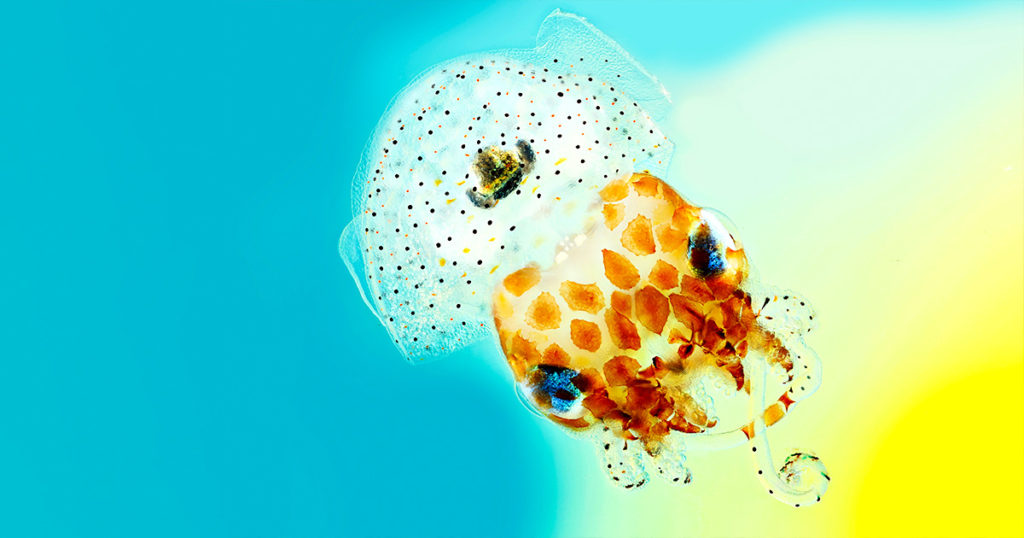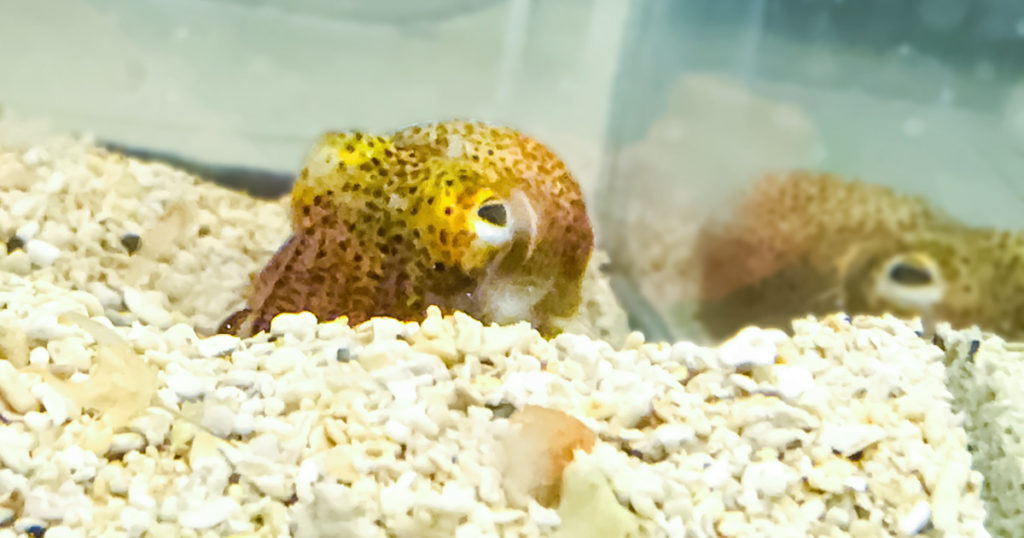Imagine a scenario—you’re studying the developmental biology of a species of squid. The squid don’t reproduce in captivity, so females carrying fertilized eggs are collected from the wild and rehomed in your lab’s aquariums. You’ve monitored all the normal aquarium conditions—pH, temperature, salinity—ensuring the animal’s new home mimics its natural environment.
But then, for no reason apparent to you, the clutch of eggs doesn’t develop and doesn’t hatch, derailing your research program until next year when you can collect more adult squid from the wild. What went wrong?

Bethany Rader, an assistant professor at Southern Illinois University, faced this exact scenario.
Unlike previous years, Rader’s 2017 cohort of Hawaiian bobtail squids—an important model organism for the symbiotic relationships Rader studies—did not lay productive eggs. The adult squid had every sign of being healthy, the aquarium conditions were optimal and the squid had been collected from the same coastal region of Hawaii as in previous years.
Rader’s colleague at SIU, Scott Hamilton-Brehm, an environmental microbiologist, suggested a potential cause.
“What made this cohort different from other years? It’s got to be the microbiome, there’s something in the aquariums,” Hamilton-Brehm said.
In a study published in the Journal of Applied Microbiology, Hamilton-Brehm and Rader characterized the aquarium microbiome of “productive” and “unproductive” Hawaiian bobtail squid cohorts. Their results provide a “fingerprint” of a healthy aquaculture environment for the squid and could help researchers create more authentic and healthy environments for the animals in research setting.
A Glowing Partnership
Besides the undeniable cuteness of Hawaiian bobtail squid, why would biologists like Rader even be interested in studying these paperclip-sized, speckled cephalopods?
Hawaiian bobtail squid, or Euprymna scolopes, form a symbiotic relationship with a bioluminescent bacteria called Vibrio fischeri. At night, V. fischeri living within a Hawaiian bobtail squid’s body glow a soft, pale blue. While this glow is imperceptible to human eyes, it allows E. scolopes to blend into moonlit coastal waters and hide from prey and predators. As dawn nears, the squid vents about 95% of the V. fischeri back into the ocean, and the remaining 5% grows during the day to again camouflage the squid at night.
Baby E. scolopes begin this daily cycle from the day they hatch. How this animal-bacteria pair works together is the subject of much study, including what factors allow beneficial bacteria to form colonies in animal hosts.
Unraveling the Environmental Microbiome
A microbiome is the collection of all the bacteria living in a specific system. Environmental microbiome studies look at the microorganisms present in soil or water samples, for example. As with human health, the ability of pathogenic microbes to affect the health of aquatic animals is a given. But characterizing the whole, interacting ecosystem of an aquarium’s microbiome and what parts of that ecosystem make an animal healthy or unhealthy is a relatively new focus for aquaculture.
Before Rader and Hamilton-Brehm’s study, no one had characterized the microbiome of the laboratory aquariums housing E. scolopes. Rader’s 2017 cohort of squids whose eggs did not develop properly provided an opportunity to gather information on what types of microbial communities lead to healthy, normal squid embryos and which communities don’t.
“No one had caught the event we had,” Hamilton-Brehm said. “No one can propagate these squids in captivity, so providing this type of information would greatly help.”
To characterize the aquarium microbiome, the research team sampled microorganisms from the aquarium water and sediment of the unproductive 2017 squid cohort and of cohorts from 2018 and 2019 whose eggs did develop and hatch.

The team then applied next generation sequencing of the 16S ribosomal RNA gene on the samples. This gene is a genetic marker commonly used to classify bacteria in microbiome studies. Similar analysis was performed for water samples taken from the squid’s coastal habitat.
Based on the bacterial genera that could be identified, the samples taken from the unproductive squids’ aquarium water had less diversity of bacteria than the samples from productive aquarium waters and from the squids’ natural habitat.
“It wasn’t as obvious as the presence or absence of a particular clade. It was just the lowering of the diversity needed to survive,” Hamilton-Brehm said.
Digging Deeper
The researchers found that the unproductive cohort’s aquariums had higher levels of nitrates in the water. They also saw that there were differences in abundance of bacterial genera associated with nitrate-removal in those samples compared to the productive tanks and natural habitat waters. Hamilton-Brehm suggested these finds point to a potential role of the microbiome in regulating the geochemistry of the aquarium water.
“Any ecosystem is dependent on the microbes present and if the microbes are not in numbers to maintain the right balance, the larger organism may suffer for it,” Hamilton-Brehm said.
Because of the relationship between E. scolopes and its bioluminescent symbiote, the research team wanted to quantify the detectable V. fischeri in the tank waters. For that analysis, they used Promega Rapid GoTaq® PCR master mix to amplify genetic sequences specific to V. fischeri.
“You can do this experiment in 30 minutes, which is fantastic because we had a ton of samples to go through,” Hamilton-Brehm said.
However, the team couldn’t consistently detect meaningful quantities of V. fischeri in the tank water, which was surprising because E. scolopes vents V. fischeri every day. These results further characterized what a “normal” microbiome for Hawaiian bobtail squids’ aquariums looks like.
A Squid Probiotic?
This research establishes a baseline of a healthy microbiome in Hawaiian bobtail squid aquariums. With this foundational work in hand, Hamilton-Brehm plans to characterize the Hawaiian bobtail squid’s aquarium microbiome in more detail, collecting more samples and using metagenomic sequencing methods. He envisions a probiotic “supplement” that could improve aquaculture conditions for the squid, enabling more consistent hatchings and even allowing the squid to be bred in captivity:
“It took a lot of time over years to catch different events. This is laying down the first framework for this idea, but obviously this means more work needs to be done,” Hamilton-Brehm said.
Latest posts by Jordan Nutting (see all)
- The Central Dogma of Promega: The Story and Science Behind Our Kit Packaging Design - May 7, 2024
- Silencing the Immunogenicity of AAV Vectors - April 4, 2024
- Discovering Cyclic Peptides with a “One-Pot” Synthesis and Screening Method - February 29, 2024
